Kaushik Roy
Alex
TRIM: Token-wise Attention-Derived Saliency for Data-Efficient Instruction Tuning
Oct 08, 2025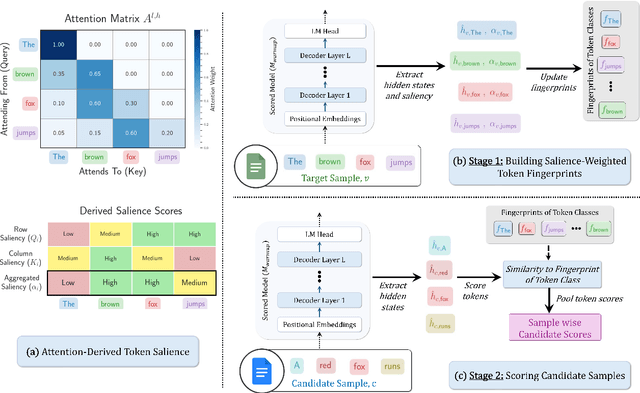
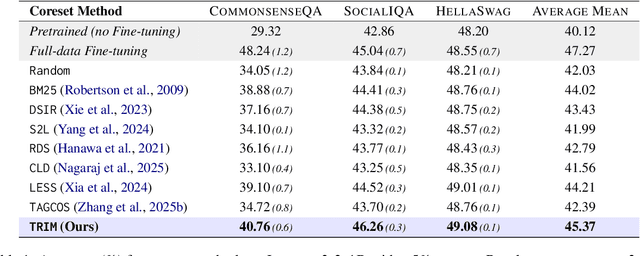
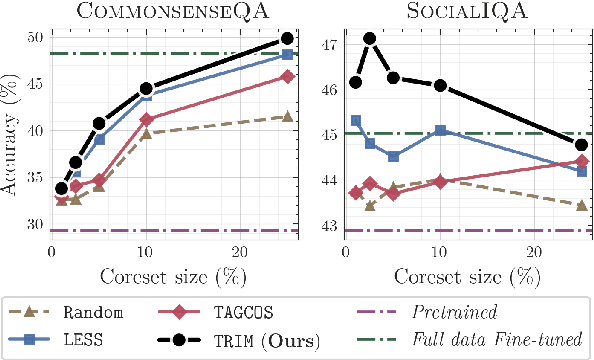

Abstract:Instruction tuning is essential for aligning large language models (LLMs) to downstream tasks and commonly relies on large, diverse corpora. However, small, high-quality subsets, known as coresets, can deliver comparable or superior results, though curating them remains challenging. Existing methods often rely on coarse, sample-level signals like gradients, an approach that is computationally expensive and overlooks fine-grained features. To address this, we introduce TRIM (Token Relevance via Interpretable Multi-layer Attention), a forward-only, token-centric framework. Instead of using gradients, TRIM operates by matching underlying representational patterns identified via attention-based "fingerprints" from a handful of target samples. Such an approach makes TRIM highly efficient and uniquely sensitive to the structural features that define a task. Coresets selected by our method consistently outperform state-of-the-art baselines by up to 9% on downstream tasks and even surpass the performance of full-data fine-tuning in some settings. By avoiding expensive backward passes, TRIM achieves this at a fraction of the computational cost. These findings establish TRIM as a scalable and efficient alternative for building high-quality instruction-tuning datasets.
FedP3E: Privacy-Preserving Prototype Exchange for Non-IID IoT Malware Detection in Cross-Silo Federated Learning
Jul 09, 2025Abstract:As IoT ecosystems continue to expand across critical sectors, they have become prominent targets for increasingly sophisticated and large-scale malware attacks. The evolving threat landscape, combined with the sensitive nature of IoT-generated data, demands detection frameworks that are both privacy-preserving and resilient to data heterogeneity. Federated Learning (FL) offers a promising solution by enabling decentralized model training without exposing raw data. However, standard FL algorithms such as FedAvg and FedProx often fall short in real-world deployments characterized by class imbalance and non-IID data distributions -- particularly in the presence of rare or disjoint malware classes. To address these challenges, we propose FedP3E (Privacy-Preserving Prototype Exchange), a novel FL framework that supports indirect cross-client representation sharing while maintaining data privacy. Each client constructs class-wise prototypes using Gaussian Mixture Models (GMMs), perturbs them with Gaussian noise, and transmits only these compact summaries to the server. The aggregated prototypes are then distributed back to clients and integrated into local training, supported by SMOTE-based augmentation to enhance representation of minority malware classes. Rather than relying solely on parameter averaging, our prototype-driven mechanism enables clients to enrich their local models with complementary structural patterns observed across the federation -- without exchanging raw data or gradients. This targeted strategy reduces the adverse impact of statistical heterogeneity with minimal communication overhead. We evaluate FedP3E on the N-BaIoT dataset under realistic cross-silo scenarios with varying degrees of data imbalance.
Enhancing Deepfake Detection using SE Block Attention with CNN
Jun 12, 2025Abstract:In the digital age, Deepfake present a formidable challenge by using advanced artificial intelligence to create highly convincing manipulated content, undermining information authenticity and security. These sophisticated fabrications surpass traditional detection methods in complexity and realism. To address this issue, we aim to harness cutting-edge deep learning methodologies to engineer an innovative deepfake detection model. However, most of the models designed for deepfake detection are large, causing heavy storage and memory consumption. In this research, we propose a lightweight convolution neural network (CNN) with squeeze and excitation block attention (SE) for Deepfake detection. The SE block module is designed to perform dynamic channel-wise feature recalibration. The SE block allows the network to emphasize informative features and suppress less useful ones, which leads to a more efficient and effective learning module. This module is integrated with a simple sequential model to perform Deepfake detection. The model is smaller in size and it achieves competing accuracy with the existing models for deepfake detection tasks. The model achieved an overall classification accuracy of 94.14% and AUC-ROC score of 0.985 on the Style GAN dataset from the Diverse Fake Face Dataset. Our proposed approach presents a promising avenue for combating the Deepfake challenge with minimal computational resources, developing efficient and scalable solutions for digital content verification.
CURE: Concept Unlearning via Orthogonal Representation Editing in Diffusion Models
May 19, 2025Abstract:As Text-to-Image models continue to evolve, so does the risk of generating unsafe, copyrighted, or privacy-violating content. Existing safety interventions - ranging from training data curation and model fine-tuning to inference-time filtering and guidance - often suffer from incomplete concept removal, susceptibility to jail-breaking, computational inefficiency, or collateral damage to unrelated capabilities. In this paper, we introduce CURE, a training-free concept unlearning framework that operates directly in the weight space of pre-trained diffusion models, enabling fast, interpretable, and highly specific suppression of undesired concepts. At the core of our method is the Spectral Eraser, a closed-form, orthogonal projection module that identifies discriminative subspaces using Singular Value Decomposition over token embeddings associated with the concepts to forget and retain. Intuitively, the Spectral Eraser identifies and isolates features unique to the undesired concept while preserving safe attributes. This operator is then applied in a single step update to yield an edited model in which the target concept is effectively unlearned - without retraining, supervision, or iterative optimization. To balance the trade-off between filtering toxicity and preserving unrelated concepts, we further introduce an Expansion Mechanism for spectral regularization which selectively modulates singular vectors based on their relative significance to control the strength of forgetting. All the processes above are in closed-form, guaranteeing extremely efficient erasure in only $2$ seconds. Benchmarking against prior approaches, CURE achieves a more efficient and thorough removal for targeted artistic styles, objects, identities, or explicit content, with minor damage to original generation ability and demonstrates enhanced robustness against red-teaming.
LogicTree: Structured Proof Exploration for Coherent and Rigorous Logical Reasoning with Large Language Models
Apr 18, 2025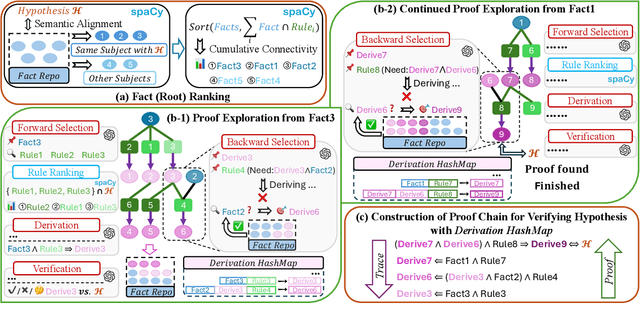
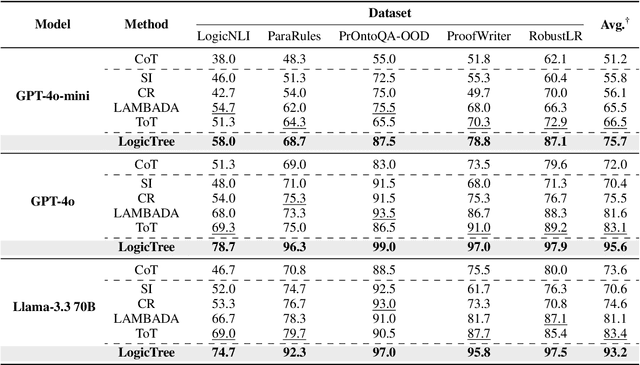

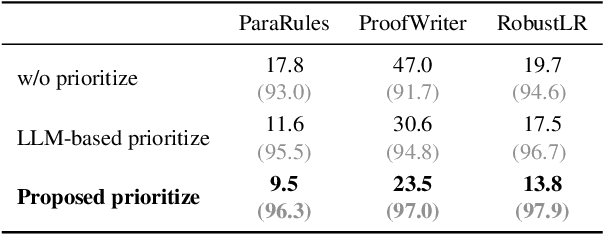
Abstract:Large language models (LLMs) have achieved remarkable multi-step reasoning capabilities across various domains. However, LLMs still face distinct challenges in complex logical reasoning, as (1) proof-finding requires systematic exploration and the maintenance of logical coherence and (2) searching the right combination of premises at each reasoning step is inherently challenging in tasks with large premise space. To address this, we propose LogicTree, an inference-time modular framework employing algorithm-guided search to automate structured proof exploration and ensure logical coherence. Advancing beyond tree-of-thought (ToT), we incorporate caching mechanism into LogicTree to enable effective utilization of historical knowledge, preventing reasoning stagnation and minimizing redundancy. Furthermore, we address the combinatorial complexity of premise search by decomposing it into a linear process. The refined premise selection restricts subsequent inference to at most one derivation per step, enhancing reasoning granularity and enforcing strict step-by-step reasoning. Additionally, we introduce two LLM-free heuristics for premise prioritization, enabling strategic proof search. Experimental results on five datasets demonstrate that LogicTree optimally scales inference-time computation to achieve higher proof accuracy, surpassing chain-of-thought (CoT) and ToT with average gains of 23.6% and 12.5%, respectively, on GPT-4o. Moreover, within LogicTree, GPT-4o outperforms o3-mini by 7.6% on average.
Towards Scalable Modeling of Compressed Videos for Efficient Action Recognition
Mar 17, 2025
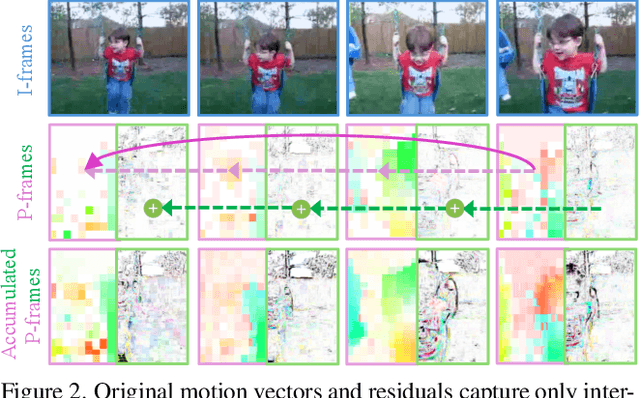

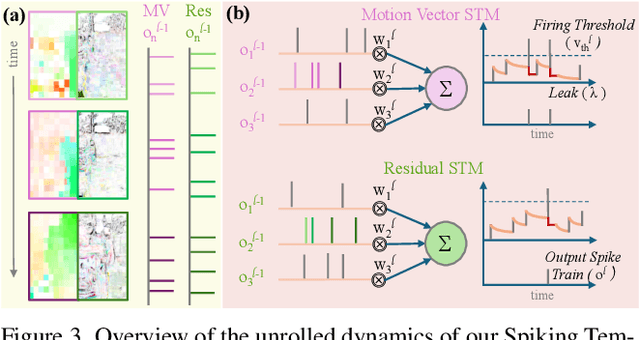
Abstract:Training robust deep video representations has proven to be computationally challenging due to substantial decoding overheads, the enormous size of raw video streams, and their inherent high temporal redundancy. Different from existing schemes, operating exclusively in the compressed video domain and exploiting all freely available modalities, i.e., I-frames, and P-frames (motion vectors and residuals) offers a compute-efficient alternative. Existing methods approach this task as a naive multi-modality problem, ignoring the temporal correlation and implicit sparsity across P-frames for modeling stronger shared representations for videos of the same action, making training and generalization easier. By revisiting the high-level design of dominant video understanding backbones, we increase inference speed by a factor of $56$ while retaining similar performance. For this, we propose a hybrid end-to-end framework that factorizes learning across three key concepts to reduce inference cost by $330\times$ versus prior art: First, a specially designed dual-encoder scheme with efficient Spiking Temporal Modulators to minimize latency while retaining cross-domain feature aggregation. Second, a unified transformer model to capture inter-modal dependencies using global self-attention to enhance I-frame -- P-frame contextual interactions. Third, a Multi-Modal Mixer Block to model rich representations from the joint spatiotemporal token embeddings. Experiments show that our method results in a lightweight architecture achieving state-of-the-art video recognition performance on UCF-101, HMDB-51, K-400, K-600 and SS-v2 datasets with favorable costs ($0.73$J/V) and fast inference ($16$V/s). Our observations bring new insights into practical design choices for efficient next-generation spatiotemporal learners. Code is available.
Finding the Muses: Identifying Coresets through Loss Trajectories
Mar 12, 2025Abstract:Deep learning models achieve state-of-the-art performance across domains but face scalability challenges in real-time or resource-constrained scenarios. To address this, we propose Loss Trajectory Correlation (LTC), a novel metric for coreset selection that identifies critical training samples driving generalization. $LTC$ quantifies the alignment between training sample loss trajectories and validation set loss trajectories, enabling the construction of compact, representative subsets. Unlike traditional methods with computational and storage overheads that are infeasible to scale to large datasets, $LTC$ achieves superior efficiency as it can be computed as a byproduct of training. Our results on CIFAR-100 and ImageNet-1k show that $LTC$ consistently achieves accuracy on par with or surpassing state-of-the-art coreset selection methods, with any differences remaining under 1%. LTC also effectively transfers across various architectures, including ResNet, VGG, DenseNet, and Swin Transformer, with minimal performance degradation (<2%). Additionally, LTC offers insights into training dynamics, such as identifying aligned and conflicting sample behaviors, at a fraction of the computational cost of traditional methods. This framework paves the way for scalable coreset selection and efficient dataset optimization.
Real-Time Neuromorphic Navigation: Guiding Physical Robots with Event-Based Sensing and Task-Specific Reconfigurable Autonomy Stack
Mar 11, 2025
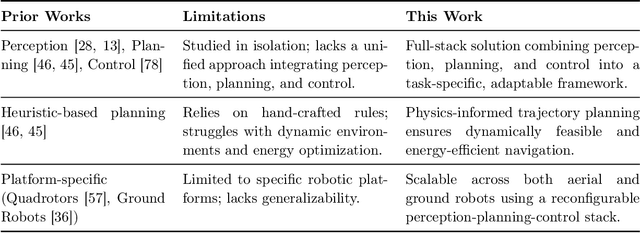
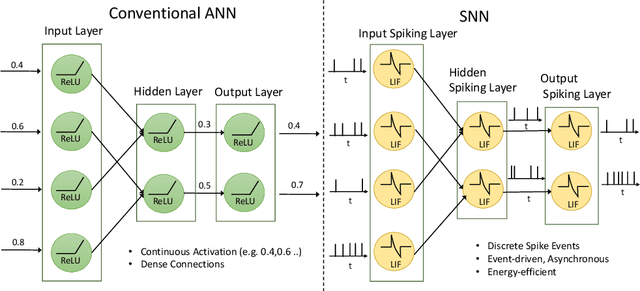

Abstract:Neuromorphic vision, inspired by biological neural systems, has recently gained significant attention for its potential in enhancing robotic autonomy. This paper presents a systematic exploration of a proposed Neuromorphic Navigation framework that uses event-based neuromorphic vision to enable efficient, real-time navigation in robotic systems. We discuss the core concepts of neuromorphic vision and navigation, highlighting their impact on improving robotic perception and decision-making. The proposed reconfigurable Neuromorphic Navigation framework adapts to the specific needs of both ground robots (Turtlebot) and aerial robots (Bebop2 quadrotor), addressing the task-specific design requirements (algorithms) for optimal performance across the autonomous navigation stack -- Perception, Planning, and Control. We demonstrate the versatility and the effectiveness of the framework through two case studies: a Turtlebot performing local replanning for real-time navigation and a Bebop2 quadrotor navigating through moving gates. Our work provides a scalable approach to task-specific, real-time robot autonomy leveraging neuromorphic systems, paving the way for energy-efficient autonomous navigation.
Learning to Localize Leakage of Cryptographic Sensitive Variables
Mar 10, 2025Abstract:While cryptographic algorithms such as the ubiquitous Advanced Encryption Standard (AES) are secure, *physical implementations* of these algorithms in hardware inevitably 'leak' sensitive data such as cryptographic keys. A particularly insidious form of leakage arises from the fact that hardware consumes power and emits radiation in a manner that is statistically associated with the data it processes and the instructions it executes. Supervised deep learning has emerged as a state-of-the-art tool for carrying out *side-channel attacks*, which exploit this leakage by learning to map power/radiation measurements throughout encryption to the sensitive data operated on during that encryption. In this work we develop a principled deep learning framework for determining the relative leakage due to measurements recorded at different points in time, in order to inform *defense* against such attacks. This information is invaluable to cryptographic hardware designers for understanding *why* their hardware leaks and how they can mitigate it (e.g. by indicating the particular sections of code or electronic components which are responsible). Our framework is based on an adversarial game between a family of classifiers trained to estimate the conditional distributions of sensitive data given subsets of measurements, and a budget-constrained noise distribution which probabilistically erases individual measurements to maximize the loss of these classifiers. We demonstrate our method's efficacy and ability to overcome limitations of prior work through extensive experimental comparison with 8 baseline methods using 3 evaluation metrics and 6 publicly-available power/EM trace datasets from AES, ECC and RSA implementations. We provide an open-source PyTorch implementation of these experiments.
Energy-Efficient Autonomous Aerial Navigation with Dynamic Vision Sensors: A Physics-Guided Neuromorphic Approach
Feb 09, 2025



Abstract:Vision-based object tracking is a critical component for achieving autonomous aerial navigation, particularly for obstacle avoidance. Neuromorphic Dynamic Vision Sensors (DVS) or event cameras, inspired by biological vision, offer a promising alternative to conventional frame-based cameras. These cameras can detect changes in intensity asynchronously, even in challenging lighting conditions, with a high dynamic range and resistance to motion blur. Spiking neural networks (SNNs) are increasingly used to process these event-based signals efficiently and asynchronously. Meanwhile, physics-based artificial intelligence (AI) provides a means to incorporate system-level knowledge into neural networks via physical modeling. This enhances robustness, energy efficiency, and provides symbolic explainability. In this work, we present a neuromorphic navigation framework for autonomous drone navigation. The focus is on detecting and navigating through moving gates while avoiding collisions. We use event cameras for detecting moving objects through a shallow SNN architecture in an unsupervised manner. This is combined with a lightweight energy-aware physics-guided neural network (PgNN) trained with depth inputs to predict optimal flight times, generating near-minimum energy paths. The system is implemented in the Gazebo simulator and integrates a sensor-fused vision-to-planning neuro-symbolic framework built with the Robot Operating System (ROS) middleware. This work highlights the future potential of integrating event-based vision with physics-guided planning for energy-efficient autonomous navigation, particularly for low-latency decision-making.
 Add to Chrome
Add to Chrome Add to Firefox
Add to Firefox Add to Edge
Add to Edge